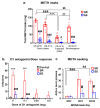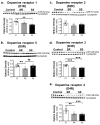Biochemical Neuroadaptations in the Rat Striatal Dopaminergic System after Prolonged Exposure to Methamphetamine Self-Administration
- PMID: 36077488
- PMCID: PMC9456063
- DOI: 10.3390/ijms231710092
Biochemical Neuroadaptations in the Rat Striatal Dopaminergic System after Prolonged Exposure to Methamphetamine Self-Administration
Abstract
Perturbations in striatal dopamine (DA) homeostasis might underlie the behavioral and pathobiological consequences of METH use disorder in humans. To identify potential consequences of long-term METH exposure, we modeled the adverse consequence DSM criterion of substance use disorders by giving footshocks to rats that had escalated their intake of METH during a drug self-administration procedure. Next, DA D1 receptor antagonist, SCH23390 was injected. Thereafter, rats were euthanized to measure several indices of the striatal dopaminergic system. Footshocks split the METH rats into two phenotypes: (i) shock-sensitive that decreased their METH-intake and (ii) shock-resistant that continued their METH intake. SCH23390 caused substantial dose-dependent reduction of METH taking in both groups. Stopping SCH23390 caused re-emergence of compulsive METH taking in shock-resistant rats. Compulsive METH takers also exhibited greater incubation of METH seeking than non-compulsive rats during withdrawal from METH SA. Analyses of DA metabolism revealed non-significant decreases (about 35%) in DA levels in resistant and sensitive rats. However, striatal contents of the deaminated metabolites, DOPAL and DOPAC, were significantly increased in sensitive rats. VMAT2 and DAT protein levels were decreased in both phenotypes. Moreover, protein expression levels of the D1-like DA receptor, D5R, and D2-like DA receptors, D3R and D4R, were significantly decreased in the compulsive METH takers. Our results parallel findings in post-mortem striatal tissues of human METH users who develop Parkinsonism after long-term METH intake and support the use of this model to investigate potential therapeutic interventions for METH use disorder.
Keywords: DOPAL; dopamine; dopamine metabolites; dopamine receptors; dorsal striatum; methamphetamine use disorder; parkinsonism.
Conflict of interest statement
The authors declare that they have no conflict of interest.
Figures







Similar articles
-
Compulsive methamphetamine taking induces autophagic and apoptotic markers in the rat dorsal striatum.Arch Toxicol. 2020 Oct;94(10):3515-3526. doi: 10.1007/s00204-020-02844-w. Epub 2020 Jul 16. Arch Toxicol. 2020. PMID: 32676729 Free PMC article.
-
Differential effects of methamphetamine and SCH23390 on the expression of members of IEG families of transcription factors in the rat striatum.Brain Res. 2010 Mar 8;1318:1-10. doi: 10.1016/j.brainres.2009.12.083. Epub 2010 Jan 6. Brain Res. 2010. PMID: 20059987 Free PMC article.
-
A single high dose of methamphetamine increases cocaine self-administration by depletion of striatal dopamine in rats.Neuroscience. 2009 Jun 30;161(2):392-402. doi: 10.1016/j.neuroscience.2009.03.060. Epub 2009 Mar 28. Neuroscience. 2009. PMID: 19336247 Free PMC article.
-
Substance P and cholecystokinin regulate neurochemical responses to cocaine and methamphetamine in the striatum.Life Sci. 2003 Jun 27;73(6):727-39. doi: 10.1016/s0024-3205(03)00393-x. Life Sci. 2003. PMID: 12801594 Review.
-
Methamphetamine addiction: involvement of CREB and neuroinflammatory signaling pathways.Psychopharmacology (Berl). 2016 May;233(10):1945-62. doi: 10.1007/s00213-016-4235-8. Epub 2016 Feb 12. Psychopharmacology (Berl). 2016. PMID: 26873080 Free PMC article. Review.
Cited by
-
Are We Getting High Cause the Thrill is Gone?J Addict Psychiatry. 2023;7(1):5-516. Epub 2023 Dec 8. J Addict Psychiatry. 2023. PMID: 38164471 Free PMC article.
-
Disruption of Dopamine Homeostasis Associated with Alteration of Proteins in Synaptic Vesicles: A Putative Central Mechanism of Parkinson's Disease Pathogenesis.Aging Dis. 2024 May 7;15(3):1204-1226. doi: 10.14336/AD.2023.0821-2. Aging Dis. 2024. PMID: 37815908 Free PMC article. Review.
-
Brain dysfunctions and neurotoxicity induced by psychostimulants in experimental models and humans: an overview of recent findings.Neural Regen Res. 2024 Sep 1;19(9):1908-1918. doi: 10.4103/1673-5374.390971. Epub 2023 Dec 15. Neural Regen Res. 2024. PMID: 38227515 Free PMC article.
-
Punishment-Induced Suppression of Methamphetamine Self-Administration Is Accompanied by the Activation of the CPEB4/GLD2 Polyadenylation Complex of the Translational Machinery.Int J Mol Sci. 2025 Mar 18;26(6):2734. doi: 10.3390/ijms26062734. Int J Mol Sci. 2025. PMID: 40141377 Free PMC article.
-
Incubation of methamphetamine craving in punishment-resistant individuals is associated with activation of specific gene networks in the rat dorsal striatum.Mol Psychiatry. 2024 Jul;29(7):1990-2000. doi: 10.1038/s41380-024-02455-2. Epub 2024 Feb 14. Mol Psychiatry. 2024. PMID: 38351172 Free PMC article.
References
-
- UNODC . World Drug Report 2020: Global Drug Use Rising; While COVID-19 Has Far Reaching Impact on Global Drug Markets. United Nations Publication; New York, NY, USA: 2020. (Sales No. E.20.XI.6)
MeSH terms
Substances
Grants and funding
LinkOut - more resources
Full Text Sources
Medical

